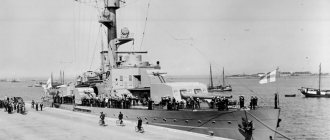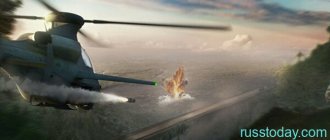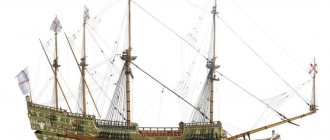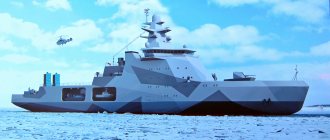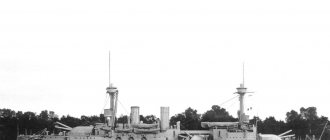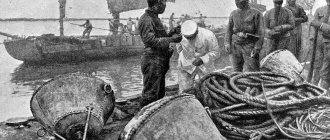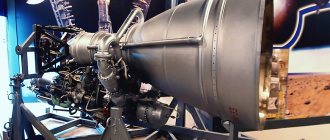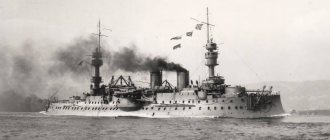Eustathius-class battleships
Squadron battleships of the “Eustathius”
“Eustathius” 11/23/1904 / 11/03/1906 / 05/28/1911 “John Chrysostom” 11/13/1904 / 05/01/1906 / 04/01/1911
Ordered as part of the shipbuilding program for 1903-1923. The programs for “distributing appropriations for shipbuilding” for 1907-1911 were mainly built on loans. in order to support the activities of “private shipyards and state-owned shipyards.” Initially, it was planned to build 2 squadron battleships for the Black Sea Fleet according to the drawings and specifications of the squadron battleship “Prince Potemkin-Tavrichesky”, which was being built at that time, with the replacement of all 152-mm guns with 203-mm ones. For financial reasons, the guns were changed only in the lower casemate. The project was developed by naval engineer Colonel Schott. They almost completely repeated the prototype, but had a more advanced design of the conning tower and armor protection system for mine artillery.
Tactical and technical data: Displacement: “John Chrysostom” – 12855 tons, “Eustathius” – 12840 tons Dimensions: length – 118.03 meters (“John Chrysostom” – 117.6 meters) width – 22.56 meters draft – 8, 23 meters Power plant: 2 vertical triple expansion steam engines, 22 boilers, 2 propellers, 10600 hp. (“John Chrysostom” – 10804 hp) Speed: 16.5 knots (“John Chrysostom” – 16.65 knots) Cruising range: 1,600/1,884 miles (16/12 knots) / (“John Chrysostom” – 1,300/2,100 miles (16/10 knots) Crew: 928 people (“John Chrysostom” - 926 people) Armament: 2x2 305/40, 4x1 203/50, 12x1 152/45 and 14x1 75/50 mm guns, 4x1 7 ,62-mm machine guns, 2 underwater 457-mm torpedo tubes Reservations: side from 152 to 229 mm, deck from 38 to 76 mm, conning tower - 203 mm, turrets - 254 mm, casemates from 127 to 152 mm
“John Chrysostom” was included in the list of ships of the Black Sea Fleet on July 13, 1903 and laid down on the boathouse of the Lazarevsky Admiralty in Sevastopol on November 13, 1904, launched on May 1, 1906, and entered service on April 1, 1911. On October 10, 1907, she was reclassified as a battleship. On August 11, 1911, together with the battleships Panteleimon, Evstafiy and Rostislav, he formed a brigade of Black Sea battleships. In 1911, the main bow compass was moved to the forward conning tower, and the upper navigation bridge was dismantled. Participated in the First World War. With its start, 6 75 mm guns were removed from the spardeck, with the aim of replacing them with 4 152 mm, and then with 4 203 mm guns. But due to the shortage of the latter that arose in connection with the hostilities, these plans were abandoned. In 1916, all 75 mm guns were removed from the ship. Participated in the shelling of the coast and ports of Zunguldak, Kilimli, Kozlu and Varna, and in operations on enemy communications. Covered military transportation and mine-laying operations of diverse naval forces. On December 29, 1917 it became part of the Red Black Sea Fleet. Since March 1918, it was in storage in the Sevastopol military port, where on May 1, 1918 it was captured by the German occupiers, and on November 24, 1918 by the Anglo-French interventionists and on April 22-24, 1919, by order of the British command, it was blown up and put out of action. On April 29, 1919, it was liberated by units of the Ukrainian Front of the Red Army, but on June 24, 1919, it was captured by the White Guards. After the liberation of Sevastopol on November 15, 1920 by units of the Red Army, it was not put into operation; in 1923 it was handed over to the Komgosfondov for dismantling and cutting into metal and on November 21, 1925 it was excluded from the lists of the Red Army.
“Eustathius” (from July 6, 1921 - “Revolution”) On July 13, 1903, was included in the list of ships of the Black Sea Fleet and on November 23, 1904, was laid down on the boathouse of the Nikolaev Admiralty, launched on November 3, 1906, and entered service on May 28, 1911 . On October 10, 1907, she was reclassified as a battleship. On August 11, 1911, together with the battleships Panteleimon, John Chrysostom and Rostislav, he formed a brigade of Black Sea battleships. In 1911, the main bow compass was moved to the forward conning tower, and the upper navigation bridge was dismantled. Participated in the First World War. With its start, 6 75 mm guns were removed from the spardeck, with the aim of replacing them with 4 152 mm, and then with 4 203 mm guns. But due to the shortage of the latter that arose in connection with the hostilities, these plans were abandoned. In 1916, all 75 mm guns were removed from the ship. Participated in the shelling of the coast and ports of Zunguldak, Kilimli, Kozlu and Varna, and in operations on enemy communications. Covered military transportation and mine-laying operations of heterogeneous naval forces, four times engaged in artillery battles with the German-Turkish battle cruiser Yavuz (Goeben) and the light cruiser Midilie (Breslau). On December 29, 1917 it became part of the Red Black Sea Fleet. Since March 1918, it was in storage in the Sevastopol military port, where on May 1, 1918 it was captured by the German occupiers, and on November 24, 1918 by the Anglo-French interventionists and on April 22-24, 1919, by order of the British command, it was blown up and put out of action. On April 29, 1919, it was liberated by units of the Ukrainian Front of the Red Army, but on June 24, 1919, it was captured by the White Guards. After the liberation of Sevastopol on November 15, 1920 by units of the Red Army, it was not put into operation; in 1922 it was handed over to the Komgosfondov for dismantling and cutting into metal and on November 21, 1925 it was excluded from the lists of the Red Army.
Battleship Eustathius (Russia, 1996)
If there were already several articles about USSR stamps on the site, then we can say that there were no Russian stamps dedicated to the fleet on the site yet (Columbus does not count). I'll fix it immediately. Today's story will be about the battleship Eustathius, depicted on a 1996 Russian stamp, and her last battle.
| Title: Battleship "Eustathius" (series of stamps "300 years of the Russian Navy. Historical and modern ships of the Navy") Country: Russia Date of issue: July 26, 1996 Size: 58x26 mm Perforation: comb 12 x 12½ Paper: coated Printing: offset + metallography Artist: Pletnev A. Circulation: 550,000 Catalog code: Mikhel RU 519 ITC “Marka” 300 |
About the ship "Eustathius"
The battleship of the Baltic Fleet “Saint Eustathius Plakida” was built at the Admiralty shipyards in St. Petersburg by master Ulfov. It was laid down on July 30, 1762.
Ship characteristics:
- length - 47.4 m (155 ft 6 in)
- dirin - 14.65 m (41 ft 6 in)
- draft - 4.5 m
- armament - 66 36 and 18 pound guns
The ship received its name in honor of the Holy Great Martyr Eustathius, the heavenly patron of the son of Empress Catherine II, Tsarevich Paul.
The ship took part in hostilities in the Mediterranean Sea during the first Russian-Turkish war of 1768–1774. Killed in a battle with the Turkish fleet in the Chios Strait on June 24 (July 5), 1770.
Battle of Chios
On July 18, 1760, a squadron of the Baltic Fleet under the command of Admiral Grigory Andreevich Spiridov left Kronstadt and headed for the Mediterranean Sea. The squadron consisted of 7 battleships (“Svyatoslav”, “Three Hierarchs”, “Iannuarius”, “Europe”, “Three Saints”, “Northern Eagle”, “Eustathius”), the frigate “Hope of Well-being”, the bombardment ship “Thunder” , 4 kicks and 2 messenger ships. The squadron had 640 guns and 5,582 crew members (including 3,061 sailors, 1,106 naval soldiers, 448 naval gunners and 967 soldiers of the Kegskolm Regiment, land artillerymen and craftsmen).
The mission of the squadron was defined as follows:
Since the main goal of our entire plan is to raise the peoples subject to them against the Turks, therefore, all other operations must give first place to it... The first object is and should always be the land operations of Count A. Orlov.”
Spiridov was supposed to deliver a land landing force to Greece, and also cover the troops from the sea, preventing Turkish ships. Catherine II, inspired by Count Orlov's plan, had high hopes for this operation:
I tickled our sailors so much in their craft that they became fire... I now have the fleet in excellent care, and I will truly use it as God commands, as it has never been before
Spiridov's transition to the Mediterranean Sea was long and associated with many disasters. Many sailors fell ill, and the ships, unprepared for long journeys, suffered greatly during the autumn-winter storms. The boldness and even riskiness of the plan lay in the fact that since the creation of a regular navy in Russia, its ships had never left the Baltic Sea. At the end of December 1769, only 4 ships and 4 small vessels arrived at the assembly point in Port Mahon in Minorca; all the rest were being repaired in different ports.
The passage of ships from the Baltic to the Mediterranean Sea. Hood. I. Rodionov
From Port Mahon, a detachment of 3 ships went to Livorno, at the disposal of Count A. Orlov, who was there, the remaining 5 ships in mid-February 1770 approached Morea, where they landed troops in the port of Vitula, which were joined by rebel local residents.
The defeats at Modon and Tripolitsa convinced Orlov that it was wrong to rely on the successful assistance of local residents, and after leaving Navarino, the count decided to focus on naval operations. Spiridov's squadron was united with another squadron that arrived in the Mediterranean under the command of an Englishman in Russian service, Elfiston. The admirals did not get along very well with each other, and Orlov himself took over the leadership of the united fleet.
Portrait of Count A.G. Orlova against the backdrop of the Battle of Chesma. Unknown artist. XIX century From the collections of the State Hermitage
The combined squadron consisted of 9 battleships, 3 frigates, 1 bombardment ship, 3 kicks, 1 packet boat and 13 mercenary and prize ships. Count Orlov held his pennant on the battleship Three Hierarchs, commanded by Samuil Karlovich Greig. Spiridov held the flag on the Eustathia, commanded by captain (later famous admiral) Alexander Ivanovich Cruz, Elphinstone was on the battleship Svyatoslav. In addition, the brother of the commander-in-chief, Major General Count Fedor Orlov, was on Spiridov’s ship.
Russian cruisers sent in search of the Turkish fleet found it anchored in the Chios Strait off the coast of Asia Minor. The Turks, including 16 ships, 6 frigates and up to 60 small ships, galleys, etc., stood in a disorderly line near the shore on the northern side of the entrance to Chesme Bay. The fleet was commanded by the famous Algerian sailor Jaizairmo Hassan Bey. The chief commander of the fleet, Captain Pasha Hassan-Eddin, was in the ground forces camp located on the nearest shore.
On June 24, 1770, at 11 o'clock in the morning, with a calm northwest wind, the Russian fleet, forming a line, set off against the enemy. The first was the ship "Europe" under the command of Captain Klokachev, followed by Spiridov on the ship "Eustathius". Only when they came within range of a rifle shot at Spiridov’s command “Start battle with the enemy!” did the Russian ships open fire. Soon, Captain Klokachev, at the insistence of the Greek pilot pointing to the shoal, turned the Europa onto starboard tack and immediately heard Spiridov’s voice from the admiral’s ship: “Congratulations on you as a sailor.” Spiridov decided that Klokachev had chickened out and was leaving the fight and decided to roughly punish him. "Eustathius" took a place in the vanguard of the Russian line and was immediately attacked by fire from three Turkish ships.
Spiridov with extraordinary composure walked along the deck of the Eustathius with a drawn sword and the image of St. John the Warrior on his chest, with which the Empress blessed him. An orchestra thundered right there on the poop deck, the musicians of which were ordered to play “to the last.” Almost all of the rigging on the Eustathia was damaged and, almost uncontrollable, it fell onto the Turkish admiral's ship Real Mustafa.
Admiral Spiridov. USSR stamp, 1987 (in the collection)
Russian sailors entered into a brutal boarding battle with the Turks. One of the sailors rushed to tear off the stern Turkish flag, his right hand, extended to the flag, was wounded, he extended his left hand - she was also wounded, the sailor grabbed the flag with his teeth and only, pierced by a Turkish bayonet, fell dead on the deck with the flag in his teeth. The flag, torn to shreds, was nevertheless delivered to Spiridova on the Eustathius. Hasan Bey, running away from our sailors, threw himself overboard and was picked up by his boats. Following their captain, the Turks began to flee en masse from Real Mustafa.
The fire from the unicorns from the Eustathius set the Turkish ship on fire and the flames quickly spread to our ship. It was not possible to tow it and Spiridov, together with Fyodor Orlov, left the ship. Soon the burning mast of the Turk collapsed on the open cruise chamber and the Eustathius exploded. 620 sailors died. Captain A.I. Cruz flew into the air along with his ship, but, clinging to a piece of the mast, saved himself. Only 9 officers and 21 sailors survived with him.
Aivazovsky I.K. "Battle in the Chios Strait." 1848. Feodosia Art Gallery
At the beginning of the 2nd hour of the day, the Turkish fleet was a disorderly heap of ships hastily fleeing for protection to Chesme Bay. The flight was chaotic, the explosion of the admiral's ship brought panic to them. Our fleet pursued the Turks all the way to the bay, at the entrance to which it anchored.
This ended the day of June 24, the day of the Chios, or as it is also called, the First Battle of Chesme. Our losses, not counting Eustathius, were insignificant. The Turks received very serious damage.
Two days later, the entire Turkish fleet: 15 ships, 6 frigates, up to 50 small ships was burned in Chesme Bay. The Russian fleet did not lose a single ship, except for the specially burned four fire ships made from Greek escort ships. Our losses are 11 killed. The Turks lost up to 10 thousand people.
F. Hackert “Preparation for the attack of the Turkish fleet in Chesme Bay on the night of June 26, 1770.” USSR stamp, 1995 (in collection)
Admiral Spiridov was awarded the Order of St. Andrew the First-Called. In memory of the victory, a medal was minted; on one side the empress was depicted, on the other the burning Turkish fleet and the laconic inscription “Was”.
Medal for the Battle of Chesma
Sources and additional information: 1. Wikipedia. Grigory Andreevich Spiridov 2. Military Review website. Admiral Grigory Spiridov 3. “History of the Russian Navy (modern edition).” M., Eksmo, 2007. “Archipelago Expedition”. Essay compiled by Navy Lieutenant N.D. Kallistov 4. Veselago Feodosius Fedorovich. "A Brief History of the Russian Fleet." (book on the website “Military Literature”).
Related posts:
Coastal defense battleship "Admiral Ushakov"
Coastal defense battleships of the Admiral Ushakov type were built to protect the Baltic coast. Each of them carried four 254 mm guns (Apraksin three), four 120 mm guns and small-caliber artillery. Having a relatively small displacement (just over 4,000 tons), the ships were distinguished by powerful weapons.
After the fall of Port Arthur, the formation of the 3rd Pacific Squadron began, into which, along with the Apraksin and Senyavin, the Admiral Ushakov was included. The value of these ships lay, first of all, in their well-trained crews, who, as part of the artillery training detachment, were engaged in training fleet gunners. However, before the ships were sent, the crews were replaced, and the battleships were sent to the Far East without replacing the main caliber guns, which subsequently played a fatal role in the fate of the Admiral Ushakov.
In the Battle of Tsushima, “Admiral Ushakov was part of the 3rd combat detachment, closing the column of the squadron’s main forces. In a daytime battle on May 14, 1905, the ship, at about 3 p.m., during a firefight with the armored cruisers of Admiral Kamimura, received two large holes in the bow and fell behind the squadron. The speed of the battleship dropped to 10 knots.
At night, sailing without lighting, the Admiral Ushakov managed to avoid attacks from Japanese destroyers, but the next day it was overtaken by the armored cruisers Yakumo and Iwate. At the Japanese offer to surrender, the Russian ship opened fire. Each of the Japanese cruisers carried four 203 mm and fourteen 152 mm guns, significantly surpassing the Russian battleship in speed. And if the first salvoes of the Ushakov covered the Iwate, causing a fire on the Japanese cruiser, then later the Japanese ships stayed out of the reach of the battleship’s guns at a favorable combat distance. After a 40-minute battle, the Admiral Ushakov, when further resistance became pointless, was scuttled by the crew. Among the 94 dead officers and sailors of the Ushakov was the commander of the battleship, Vladimir Nikolaevich Miklukha (brother of the famous Oceania explorer N. N. Miklouho-Maclay). According to one version, he was mortally wounded by a shrapnel, and according to another, he himself refused to be saved, pointing out to the Japanese a sailor drowning nearby.
Squadron battleship "Sevastopol"
The battleship Sevastopol was commissioned in 1900. The ship carried four 305 mm main caliber guns. Eight 152 mm cannons were located in pairs in four turrets, and another four six-inch guns were located on the battery.
By the time the Russo-Japanese War began, the Sevastopol, along with the similar Poltava and Petropavlovsk, was far from a new ship, but destroying it in an artillery battle was very problematic.
"Sevastopol" took part in the battle on January 27, 1904, supporting the actions of ground forces at Port Arthur and the naval battle in the Yellow Sea. Several times the battleship was damaged by Japanese mines, but, unlike the Petropavlovsk, it happily escaped destruction. In October 1904, Japanese troops began methodically shooting down the ships of the 1st Pacific Squadron in the inner roadstead of Port Arthur. Only when most of the squadron was killed under the fire of Japanese siege artillery, the commander of the battleship, Captain 1st Rank Essen, on his own initiative, managed to obtain permission to take the battleship to the outer roadstead of the fortress in White Wolf Bay, where the crew began preparing to independently break the blockade.
However, the lack of people in the team and the lack of part of the artillery transferred to the shore forced them to postpone the breakthrough. Meanwhile, the Japanese command, having discovered the Sevastopol in the outer roadstead, decided to destroy the Russian battleship with destroyer attacks. Over the course of several nights, Sevastopol, protected by coastal batteries, the gunboat Groziashchiy and several destroyers, was subjected to numerous mine attacks.
Having fired up to 80 torpedoes at the Russian ship, the Japanese achieved one hit and two close explosions of torpedoes. On the Sevastopol, a number of compartments were flooded and the battleship suffered a significant list. True, this success cost the Japanese very dearly. Destroyer No. 53 and its entire crew were killed on a Russian barrage mine, and destroyer No. 42, damaged by the fire of Sevastopol, was finished off by a torpedo from the destroyer Angry.0
Another two dozen Japanese fighters and destroyers were damaged, and some, apparently, were no longer put into service until the end of the war. The damage received by the Russian ship already excluded the possibility of a breakthrough, and the Sevastopol crew switched to the fight against Japanese batteries, which continued until the very last day of the defense of Port Arthur. In connection with the surrender of the fortress, the battleship was towed from the shore and scuttled at a depth of more than 100 meters. Thus, Sevastopol became the only Russian battleship sunk in Port Arthur that was not raised by the Japanese and did not fall into enemy hands.
Description[edit]
Evstafi
was 379 feet (115.5 m) long at the waterline and 385 feet 9 inches (117.6 m) long overall. She had a beam of 74 feet (22.6 m) and a maximum draft of 28 feet (8.5 m). Her displacement was 12,738 long tons (12,942 t) as designed. [1]
She had two 3-cylinder vertical triple expansion steam engines driving two propellers. Belleville's 22 water-tube boilers provided steam for the engines. The engines had a total design output of 10,600 horsepower (7,904 kW) and provided a top speed of 16 knots (30 km/h; 18 mph). When fully loaded, she carried 1,100 long tons (1,118 t) of coal, giving her a range of 2,100 nautical miles (3,900 km; 2,400 mi) at 10 knots (19 km/h; 12 mph). [2]
Evstafi
Obukhovsky's 12-inch pattern 1895 40-caliber guns were mounted in two twin-gun turrets, one each fore and aft. Each turret had a firing angle of 260°. [3] All four 8-inch (203 mm) Model 1905 50 caliber guns were mounted in the corners of the superstructure in armored casemates. These guns had a firing angle of 120° and could fire straight forward or backward. A dozen 6-inch (152 mm) Canet Pattern 1892 45 caliber guns were mounted in the lower casemates. The anti-torpedo boat's armament consisted of 14 75-millimeter (3.0 in) Model 1892 Canets. The 50-caliber guns were mounted in sponsons on the upper deck, covered by gun shields. [4] It carried two 17.7-inch (450 mm) torpedo tubes on its side. [5]
Wartime modifications[edit]
IN
During 1915,
anti-aircraft guns were installed Evstafi turret She initially received three 75 mm guns, but these were later replaced by two 63.5 mm (2.5 in) guns and a pair of 40 mm (1.6 in) guns. [6]
Quotes
- ^ a b
McLaughlin 2003, p. 147 - McLaughlin 2003, pp. 116, 147, 149
- McLaughlin 2003, p. 46
- McLaughlin 2003, pp. 148, 151–52
- McLaughlin 2003, pp. 148, 150
- "Russian 12" / 40 (30.5 cm) Template 1895 305 mm / 40 (12 ") Template 1895". Navweaps.com. January 12, 2009. Retrieved December 22, 2009.
- ^ a b c d
McLaughlin 2003, p. 150 - "Russian 8" / 50 (20.3 cm) Template 1905 203 mm / 50 (8 ") Template 1905". Navweaps.com. May 21, 2006. Retrieved June 18, 2010.
- "Russian 6" / 45 (15.2 cm) Sample 1892 152 mm / 45 (6 ") Sample 1892". Navweps.com. January 12, 2009. Retrieved December 22, 2009.
- "Russian 75 mm / 50 (2.95") Model 1892 - French 7.5 cm / 50 (2.95") Canet Model 1891." Navweps.com. July 17, 2007. Retrieved February 18, 2010.
- ^ a b c
McLaughlin 2003, p. 151 - "Russian/USSR Torpedoes before World War II." Navweaps.com. November 19, 2008. Retrieved June 16, 2010.
- McLaughlin 2003, pp. 147, 149
- McLaughlin 2003, pp. 302–03.
- McLaughlin 2001, pp. 131–33
- McLaughlin 2001, p. 132
- ^ a b
McLaughlin 2003, p. 152 - Nekrasov, s. 55–57.
- McLaughlin 2003, p. 310
- McLaughlin 2003, p. 304
- Nekrasov, s. 90–92.
Recommendations
- Battleship portal
- Gardiner, Robert, ed. (1979). All Conway's World Warships 1860–1905
. New York: Mayflower Books. ISBN 0-8317-0302-4. - McLaughlin, Stephen (2001). "Pre-dreadnoughts versus dreadnoughts: Action off Cape Sarych, November 18, 1914." In Preston, Anthony (ed.). Warship 2001–2002
. London: Conway Maritime Press. pp. 117–40. ISBN 0-85177-901-8. - McLaughlin, Stephen (2003). Russian and Soviet battleships
. Annapolis, MD: Naval Institute Press. ISBN 1-55750-481-4. - Nekrasov, Georgy (1992). North of Gallipoli: The Black Sea Fleet in the War of 1914–1917.
.
Eastern European monographs. CCCXLIII
. Boulder, CO: East European Monographs. ISBN 0-88033-240-9.
Footnotes [edit]
- Jump up
↑ McLaughlin 2003, p. 147 - McLaughlin 2003, pp. 148, 151-52
- Jump up
↑ McLaughlin 2003, pp. 148, 150 - Jump up
↑ McLaughlin 2003, p. 150 - Jump up
↑ McLaughlin 2003, p. 151 - Jump up
↑ McLaughlin 2003, p. 310 - Jump up
↑ McLaughlin 2003, pp. 147, 152 - McLaughlin 2003, pp. 302-03
- McLaughlin 2001, pp. 131-33
- Jump up
↑ McLaughlin 2001, p. 132 - ^a bc McLaughlin 2003, p. 152
- ↑
Nekrasov, s. 55–57. - Jump up
↑ McLaughlin 2003, p. 304 - ↑
Nekrasov, pp. 90–92.

